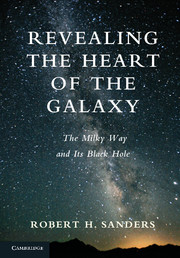Book contents
- Frontmatter
- Contents
- Acknowledgements
- 1 Introduction: The Luminous Pathway
- 2 The Discovery of the Milky Way Galaxy
- 3 The New Physics
- 4 Parting the Veil with Radio Astronomy
- 5 The Violent Universe
- 6 New Windows on the Galactic Center
- 7 The Milky Way as a Barred Spiral Galaxy
- 8 The Evolving View of Active Galactic Nuclei
- 9 The “Paradox of Youth”: Young Stars in the Galactic Center
- 10 Stellar Orbits in the Galactic Center, QED
- 11 Black Holes Here, Black Holes There…
- 12 Traces of Activity: Past, Present, and Future
- 13 After Words: Progress in Astronomy
- References
- Index
10 - Stellar Orbits in the Galactic Center, QED
Published online by Cambridge University Press: 05 December 2013
- Frontmatter
- Contents
- Acknowledgements
- 1 Introduction: The Luminous Pathway
- 2 The Discovery of the Milky Way Galaxy
- 3 The New Physics
- 4 Parting the Veil with Radio Astronomy
- 5 The Violent Universe
- 6 New Windows on the Galactic Center
- 7 The Milky Way as a Barred Spiral Galaxy
- 8 The Evolving View of Active Galactic Nuclei
- 9 The “Paradox of Youth”: Young Stars in the Galactic Center
- 10 Stellar Orbits in the Galactic Center, QED
- 11 Black Holes Here, Black Holes There…
- 12 Traces of Activity: Past, Present, and Future
- 13 After Words: Progress in Astronomy
- References
- Index
Summary
Two Mountains, Two Legends
The Hawaiian islands in the mid-Pacific are quite young on geological timescales; in fact they are still forming. The volcanic island chain runs from northwest to southeast; as the Pacific plate drifts northwestward over a weak spot in the underlying mantel, magma, hot molten basalt, occasionally bubbles up to the seabed and onto the surface forming a new island. The most recent consequence of this process is the big island of Hawaii which is less than 400 thousand years old. Its principal volcano, Mauna Kea, stands at 4207 meters (13 803 feet) above the sea, but measured from its base at the bottom of the sea it is 10 200 meters (33 500 feet), taller than Mount Everest at 8848 meters. It is a significant mountain. Although the climate of the island is wet, the summit of Mauna Kea stands above moisture in the atmosphere. It is above 90% of the water vapor and above 40% of the atmosphere itself. This makes the site ideal for astronomical observations, and since the 1950s when the first solar observatories were constructed, there has been continuing development of the summit for astronomy.
Mauna Kea is sacred for the indigenous Hawaiian people; the ancient belief is that many of their principal deities live at the summit, which plays a role rather like Mt. Olympus in Greek mythology. In the past, major chieftains ascended to the top to commune with the deities. Continuing reverence for the mountain has made the issue of observatory development quite sensitive.
- Type
- Chapter
- Information
- Revealing the Heart of the GalaxyThe Milky Way and its Black Hole, pp. 129 - 148Publisher: Cambridge University PressPrint publication year: 2013



